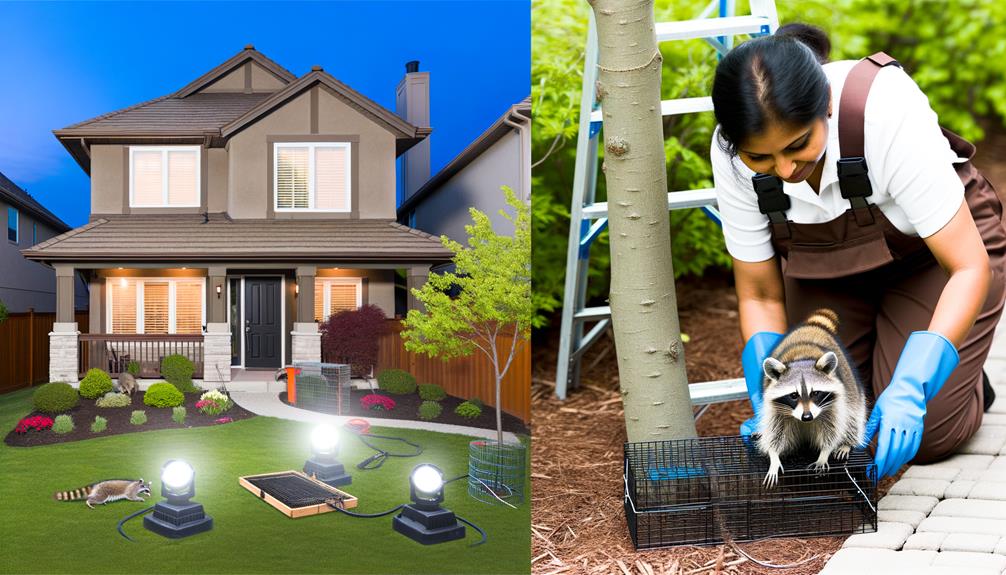How Do You Get Rid of Raccoons on Your Roof in 7 Steps
To effectively eliminate raccoons from your roof, start by identifying signs such as noises, droppings, and damage. Secure all entry points by sealing gaps and installing chimney caps.
Use raccoon-specific traps, strategically placed with proper bait. Apply natural deterrents like peppermint oil and predator urine to create an unpleasant environment.
Install physical barriers such as metal flashing and pruning tree branches to prevent access. Seek professional wildlife removal services if necessary to ensure humane and thorough removal.
Regular maintenance, including trimming trees and securing garbage bins, will help prevent future infestations. For a more detailed approach, further insights await.

Key Takeaways
- Seal entry points and repair roofing damage to prevent access.
- Install chimney caps and secure roof vents to block raccoon entry.
- Use raccoon-specific traps near entry points and check frequently.
- Apply natural deterrents like peppermint oil and predator urine around the roof.
- Trim tree branches near the roof to eliminate raccoon access pathways.
Identify Signs of Raccoons
Identifying signs of raccoons on your roof is essential for addressing the issue promptly and effectively. Common indicators include scratching or thumping noises, particularly during the night when raccoons are most active.
Visual evidence such as raccoon droppings or paw prints around the roof area can also signal their presence. Additionally, raccoons often damage roofing materials, so look for torn shingles or insulation.
A noticeable odor may emanate from their nesting sites, particularly if they have been present for an extended period. Finally, check for signs of entry points, such as gaps or holes near vents, chimneys, or eaves.
Recognizing these signs early can prevent further damage and facilitate timely intervention to remove these unwelcome guests.
Secure Entry Points
Securing entry points is essential to preventing raccoons from accessing your roof. Begin by thoroughly inspecting and sealing any potential openings, such as gaps in eaves, vents, and roof edges.
Additionally, installing chimney caps can effectively block a common entry route while maintaining proper ventilation.
Seal Potential Openings
To effectively prevent raccoons from accessing your roof, it is crucial to thoroughly seal all potential openings and secure entry points. Begin by inspecting your roof and eaves for any gaps, cracks, or holes that raccoons could exploit.
Pay special attention to areas around vents, chimneys, and soffits. Use durable materials such as metal flashing, heavy-gauge wire mesh, or hardware cloth to cover these openings securely. Make sure that vents are properly screened and repair any broken or loose shingles.
Additionally, trim tree branches that overhang the roof to eliminate easy access routes for raccoons. By meticulously sealing these potential entry points, you create a formidable barrier that helps protect your home and roof from raccoon intrusions.
Install Chimney Caps
Installing chimney caps is a highly effective method to prevent raccoons from accessing your home through the chimney. These caps act as a barrier, making it impossible for raccoons to enter while still allowing smoke and gases to escape freely.
When selecting a chimney cap, opt for a stainless-steel or heavy-duty mesh design to ensure strength and longevity. Additionally, professional installation is recommended to guarantee a secure fit.
Regular maintenance of the chimney cap is essential; inspect it periodically for any signs of wear or damage. By investing in a quality chimney cap, you not only protect your home from raccoons but also prevent other wildlife and debris from causing potential blockages and hazards.
Use Humane Traps
Implementing humane traps effectively requires selecting the right type of trap designed specifically for raccoons and making sure it is placed in a strategic location on your roof. Expertly chosen traps minimize stress and potential harm to the animal, while facilitating a safe relocation process.
To maximize success, consider the following practical advice:
- Select a raccoon-specific trap: See to it that it is large enough to comfortably capture the animal.
- Bait the trap properly: Use foods raccoons find irresistible, such as marshmallows or canned fish.
- Position the trap strategically: Place it near the suspected entry points or common pathways.
- Check traps frequently: Monitor them to avoid prolonged captivity.
- Follow local regulations: Make sure your trapping and relocation methods comply with wildlife laws.
These steps foster humane and effective raccoon removal.
Apply Natural Deterrents
Applying natural deterrents can be an effective strategy to discourage raccoons from frequenting your roof.
Peppermint oil, known for its strong scent, can be used to repel raccoons when applied to areas they frequent.
Additionally, using predator urine, such as that of a coyote, can create an environment that raccoons find threatening and hence avoid.
Use Peppermint Oil
Peppermint oil, known for its strong fragrance, can serve as an effective natural deterrent to keep raccoons off your roof. When utilized correctly, peppermint oil not only repels raccoons but also guarantees a humane approach to pest control.
To apply peppermint oil effectively, consider the following steps:
- Soak cotton balls: Drench cotton balls in peppermint oil and place them around entry points and other affected areas.
- Create a spray solution: Blend peppermint oil with water and spray it around the roof perimeter.
- Refresh regularly: Reapply the oil every few days to maintain its potency.
- Combine with other deterrents: Use in conjunction with other natural repellents for enhanced effectiveness.
- Safety considerations: Make sure the oil doesn't come into direct contact with pets or children.
Implementing these methods will help keep your roof raccoon-free.
Employ Predator Urine
Using predator urine can be a highly effective natural deterrent to keep raccoons off your roof. This method leverages the natural fear raccoons have of predators such as coyotes or foxes. By applying predator urine around the perimeter of your roof, you create a hostile environment that discourages raccoons from approaching.
Available commercially, these products are non-toxic and environmentally safe. When using predator urine, it is essential to reapply it periodically, especially after rain, to maintain its efficacy. Additionally, wearing gloves during application prevents human scent contamination, ensuring the deterrent remains effective.
Install Physical Barriers
Installing physical barriers is an effective method to deter raccoons from accessing your roof. These barriers can prevent raccoons from climbing up and causing damage or finding shelter.
Here are several practical options you can consider:
- Install chimney caps: Prevent raccoons from entering through chimneys by fitting secure caps.
- Metal flashing: Attach metal flashing around the base of trees and poles to make them unclimbable.
- Fencing: Erect fences with a minimum height of four feet, ideally with a slanted top, to hinder climbing.
- Roof vent covers: Use durable covers to secure roof vents and other openings.
- Prune branches: Trim tree branches that overhang or are close to your roof, removing access points.
Implementing these measures will help maintain a raccoon-free roof effectively.
Seek Professional Help
When physical barriers and DIY methods prove inadequate, enlisting the expertise of a professional wildlife removal service becomes necessary for effectively addressing raccoon problems on your roof.
These experts are trained to handle wildlife humanely and can implement measures that guarantee the safe and permanent removal of raccoons. Certified professionals conduct thorough inspections, identify entry points, and use specialized equipment to trap and relocate the animals.
Additionally, they provide valuable insights into raccoon behavior and potential vulnerabilities in your home's structure. By choosing a reputable service, you not only safeguard your property but also contribute to the humane treatment of wildlife.
Professional intervention minimizes risks to both humans and animals, ensuring a thorough and efficient resolution.
Prevent Future Infestations
Proactively preventing future infestations involves implementing thorough measures to secure your home against raccoon entry. Ensuring that your residence is well-protected not only safeguards your property but also upholds the well-being of your community.
Here are key steps to deter raccoons:
- Seal entry points: Inspect and repair all potential entry points, including vents, chimneys, and roof gaps.
- Trim tree branches: Keep tree limbs at least 10 feet away from the roof to prevent easy access.
- Secure garbage bins: Use raccoon-proof trash cans with tight-fitting lids.
- Install motion-activated lights: Bright lights can discourage nocturnal creatures from approaching.
- Regularly inspect and maintain: Consistent home inspections and maintenance can catch issues early.
Conclusion
Eradicating raccoons from a rooftop requires a methodical approach. This encompasses the identification of signs, securing entry points, employing humane traps, applying natural deterrents, installing physical barriers, and seeking professional help.
Adopting these steps can notably reduce the likelihood of future infestations, transforming an infested roof into an impenetrable fortress.
By implementing these expert strategies, homeowners can effectively safeguard their properties. This ensures a raccoon-free environment and prevents the myriad issues associated with these persistent and cunning intruders.






